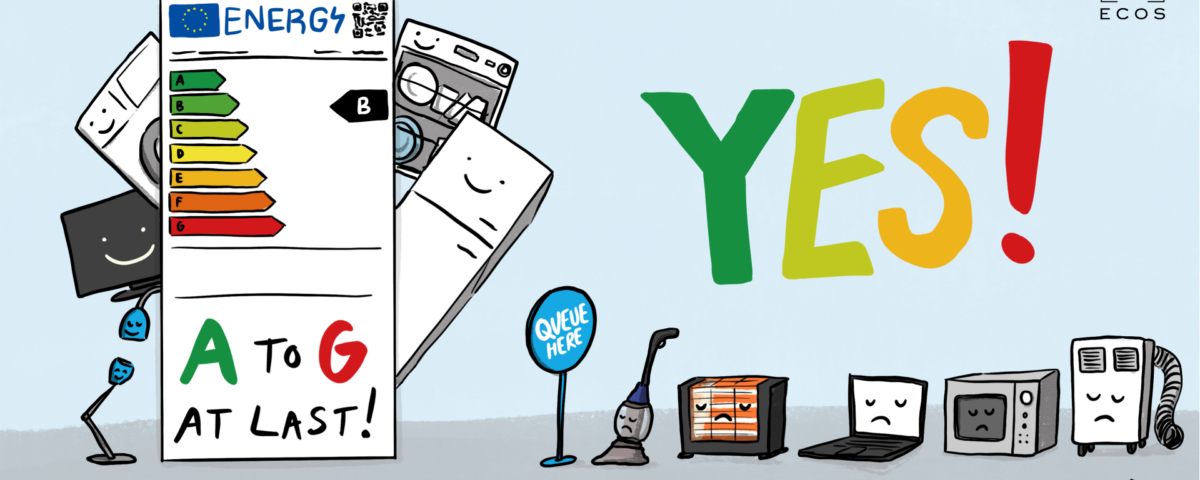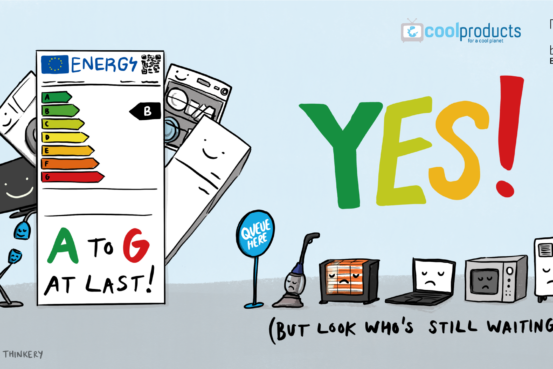Coolproducts – a group of over 20 European NGOs, co-led by ECOS and the European Environmental Bureau (EEB) – welcomes the rescaled energy labels on home appliances and TVs but asks the EU to ramp up ambition to unlock game-changing savings.
As of 1 March, four different types of electrical appliances will see their energy labels revamped: dishwashers, washing machines, refrigerators and displays (including televisions).
New labels use a simplified A-G scale, replacing categories A+, A++ and A+++. They are expected to steer consumers to more energy-efficient appliances, with the top A class empty at first, to make room for innovative improvements.
Another novelty is the addition of the QR code to the energy labels. By scanning the codes, consumers will be able to access the EU EPREL database, containing additional information about the product.
Energy labels have encouraged consumers to buy more energy-efficient products for more than 20 years. Overall, 14 product categories sport them, including most home appliances (such as washing machines or dishwashers), lamps, wall air conditioners and boilers.
On average, today energy labels help each European family save up to 285 euro every year.
Along with the revised labels, the EU is introducing new ecodesign measures for eleven product categories, preventing the worst-performing models from being sold in the EU, and obliging manufacturers to make their products more repairable.
The revised energy labels and new ecodesign measures are expected to jointly deliver 167 TWh of energy savings every year by 2030, as much as the final annual energy consumption of Denmark.
We call for higher ambition to unlock game-changing savings
Revised energy labels are set to bring about significant energy savings, but much more could be achieved if the European Commission ramped up its ambition.
Updates for the energy labels for many other products are constantly being delayed. In the last couple of years, we have seen postponements in the revision of labels for vacuum cleaners, laptops, heaters and air conditioners, to name only a few examples.
New labels will save us millions of euros – good for our pockets, and cut millions of tonnes of CO2 emissions – good for the planet. But to reach our climate ambitions, the European Commission must now move up a gear and introduce rescaled energy labels for all high energy-consuming products, such as air conditioners, heaters and vacuum cleaners. It is time to enable consumers to make the right choices – for themselves, and for the planet.
The new labels will empower consumers by making it easier for them to recognise products that can help cut energy bills, while also ensuring the market evolves in line with Europe’s climate goals. But products should also be ranked according to their level of repairability, ICT and electronics that tend to break, be replaced and discarded too often.
A quick guide to the new labels:
The revamped labels are simplified, switching back to the previous A-G scale and eliminating the A+, A++, A+++ classes.
What are the main differences between the old and new label?
· The new label uses a uniform A-G scale for all products. A+++/A+ will no longer exist
· The A class will remain empty until manufacturers find innovative solutions to develop sufficiently energy-efficient appliances.
· In the upper right corner of the label a QR-Code is introduced which will provide a direct link to the label database of the European Commission (EPREL) supporting transparency and easier market surveillance by national authorities
· The energy consumption of the products is shown in a more prominent and uniform way in the middle section of the label
· The lower part of the label contains various pictograms which inform about selected product features. Several pictograms are the same as in the old label, some have been revised and a few have been newly introduced
What else is to be considered for the new labels?
Pictograms will undergo changes, although most pictograms from the old label will also be used in the new version. Some pictograms have been slightly adapted and a few have been newly introduced (e.g. energy efficiency in HDR-Mode for TVs and displays, washing time for washing machines)
Why new energy labels?
As products grew more energy-efficient, classes above A (A+, A++, and A+++) were introduced, while the lowest classes (E, F, G) were left empty. A walk to your nearest electronics store today would show many more A ‘pluses’ than any other energy classes, giving the impression that, after all, most products are efficient.
Is there an equivalence between old and new labels?
New labels will not be directly comparable with their previous versions. A fridge labelled as A+++ today may become a C-class product. In fact, we will not see many A-labelled appliances in the next few years: the ‘A class’ is designed to remain empty for a while, as an incentive to innovation. In addition, efficiency limits behind each class will be revised on a regular basis.
More information on the new energy labels can be found at www.label2020.eu/





